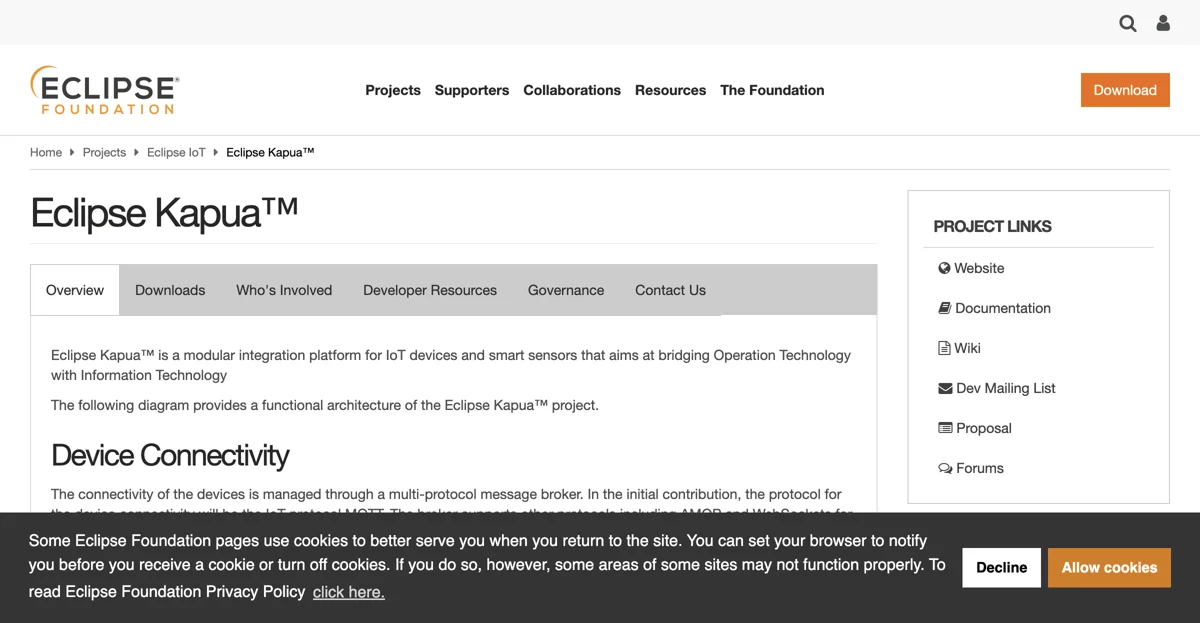Eclipse Kapua™ is a remarkable modular integration platform designed specifically for IoT devices and smart sensors. Its primary goal is to bridge the gap between Operation Technology and Information Technology, creating a seamless connection between the physical and digital worlds. The device connectivity aspect of Eclipse Kapua™ is managed through a multi-protocol message broker. In the initial contribution, the IoT protocol MQTT is used for device connectivity, while the broker also supports other protocols like AMQP and WebSockets for seamless application integration. The device connectivity module is responsible for authenticating connections, enforcing appropriate authorization, and maintaining a comprehensive Device Registry. This registry stores crucial device information such as the device profile, connection status, and connection log. It also enables efficient device organization through custom attributes and tags. The Message Routing component of Eclipse Kapua™ allows for flexible handling of message streams. It avoids hard-coded behaviors by enabling configurable message routes, ensuring that data published by devices can be directed to the appropriate consumers. For instance, command and control messages are directed to the Device Management component, while telemetry data can be archived in the IoT Platform or redirected to other systems. The Device Management component enables the IoT platform to perform remote operations on connected devices. It exposes an open contract towards the devices, with no assumptions about the device software stack. In the initial contribution, the device management contract is based on an open application protocol over MQTT, which is already implemented by the Eclipse Kura project. With this protocol, the IoT platform can perform a variety of tasks, including introspecting and managing the device configuration, managing device services such as starting and stopping operations, managing device applications including installation, update, and removal, executing remote OS commands on the device, getting and setting device attributes and resources, and provisioning the initial configuration of the devices. In its evolution and with future community contributions, Eclipse Kapua™ may adopt additional device management protocols like the emerging LWM2M standard. Data Management is another crucial aspect of Eclipse Kapua™. It can archive the telemetry data sent by devices into a persistent storage for easy application retrieval. A reference message payload is defined, which includes a timestamp, a geo position, strongly typed message headers, and an opaque message body. The chosen encoding is based on an open Google Protocol Buffers grammar. In the initial contribution, a NoSQL data storage is used to allow for flexible indexing of the telemetry messages. Incoming messages are stored and indexed by timestamp, topic, and originating asset, and the NoSQL storage also enables indexing of the message headers. Additionally, Data Management keeps a Data Registry that maintains the topics and metrics that receive incoming traffic. Security is a fundamental aspect of the IoT platform, and Eclipse Kapua™ addresses this through a foundation layer that manages tenants, accounts, and users. The account model supports a hierarchical access control structure, following Role Based Access Control (RBAC). User identities can be defined and associated with one or more permissions, ensuring the principle of "least privilege". Devices connect to the platform using the credentials of one of these user identities or through SSL authentication. For integration with existing applications, Eclipse Kapua™ offers a modern Web Services API based on Representational State Transfer (REST). The REST API exposes all the platform functionality, including device management and data management. It also offers a "bridge" to the MQTT broker, enabling the routing of commands from applications to devices without a specific connection to the message broker. Technologies such as REST/Comet/WebSockets are included, allowing for real-time display of data published by the devices in web pages and mobile dashboards. Finally, Eclipse Kapua™ features a web-based administration Console that enables users to perform all device and data management operations. The platform has a mature status and a rich history of releases, with the latest versions available from 2024-09-30 to 2017-06-07. It is licensed under the Eclipse Public License 2.0, and is supported by an active community of member companies. Overall, Eclipse Kapua™ is a powerful and comprehensive IoT integration platform that offers a wide range of features and capabilities to meet the diverse needs of the IoT ecosystem.

Eclipse Kapua™
Eclipse Kapua™ is an IoT integration platform with device management, data handling, and security features. It bridges OT and IT for seamless operations.

Top Alternatives to Eclipse Kapua™
ThingWorx
ThingWorx is an IIoT platform that helps industries transform digitally
ThingSpeak
ThingSpeak is an IoT analytics platform for data collection and analysis
IoT platform product architecture on Google Cloud
IoT platform on Google Cloud offers comprehensive device management
Particle
Particle is an AI-powered IoT platform for enhanced device management
OctoEverywhere
OctoEverywhere offers free remote access to OctoPrint, Klipper, and Bambu Lab printers, enabling users to manage their 3D printing from anywhere.
LatenceTech
LatenceTech offers AI-powered network latency monitoring solutions to enhance wireless network quality and reliability.
Insights Hub
Insights Hub is an AI-powered industrial IoT platform that helps businesses enhance manufacturing efficiency and make data-driven decisions.
Microsoft Azure
Microsoft Azure is a comprehensive cloud computing platform that offers AI and machine learning services to build innovative applications.
Azure IoT Hub
Azure IoT Hub is a cloud-based service that enables secure and scalable communication between IoT applications and devices.
Basemark
Basemark specializes in automotive AR software, enhancing driving safety and experience with real-time contextual guidance.
Nabto
Nabto is an AI-powered P2P IoT platform that enables secure, low-latency live streaming for smart surveillance cameras.
Currux Vision
Currux Vision develops autonomous AI systems for smart infrastructure, enhancing traffic monitoring and enforcement with edge and cloud solutions.
LensLink
LensLink offers innovative AIoT solutions for automatic image and video analysis, enhancing safety and business decision-making.
LeiaSR™
LeiaSR™ is an AI-powered technology platform that transforms 2D displays into 3D, offering immersive experiences on any device.
Campedia
Campedia is an AI-powered camera that identifies objects and answers questions through image recognition, powered by GPT-4 Vision.
xyzt.ai
xyzt.ai is an AI-powered platform that transforms IoT data into actionable insights through advanced spatio-temporal analysis.
Dairytech.ai
Dairytech.ai is an AI-powered dairy supply chain management solution that helps dairy farms optimize milk production, distribution, and delivery processes.
OpenALPR
OpenALPR is an AI-powered tool that simplifies automatic license plate and vehicle recognition, enhancing business capabilities and community safety.
Dubber
Dubber is an AI-powered conversation intelligence platform that helps communication service providers maximize network investment value.
YiIotCloud
YiIotCloud offers AI-powered video technology for home security and elder care, trusted by millions worldwide.
Devath
Devath is an AI-powered SmartHome platform that offers no-code device publishing and developer copilots to streamline app development.